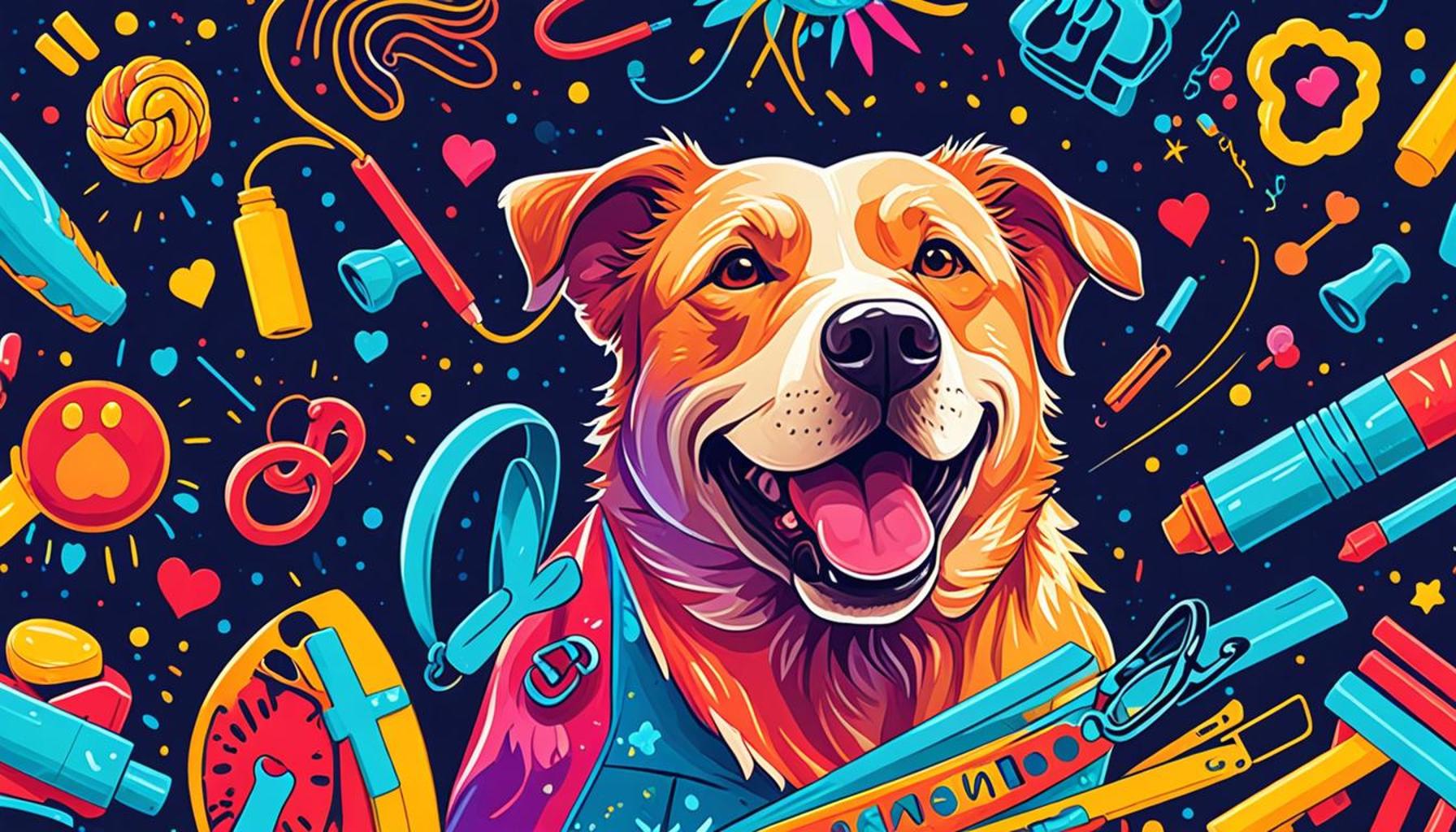Positive Reinforcement: The Key to Successful Dog Training

The Importance of Positive Reinforcement in Dog Training
The journey of dog training can often feel daunting. However, positive reinforcement emerges as a beacon of hope for pet owners and trainers alike. This technique not only fosters a stronger bond between humans and their canine companions but also leads to effective learning in a way that is harmonious and enjoyable for both parties. Research has shown that dogs trained using positive methods are more likely to display desired behaviors consistently, making the training process smoother and more enjoyable.
What makes positive reinforcement stand out in the realm of dog training? Here are some key features:
- Encourages Good Behavior: By rewarding desired actions, trainers can instill good habits over time. For instance, giving a dog a treat when it sits on command not only reinforces that behavior but also sets the stage for more complex commands later on.
- Builds Trust: Positive interactions create a safer environment for learning. When dogs associate their human companions with rewards and praise, they are likely to approach training sessions with enthusiasm and confidence, ultimately leading to a more trusting relationship.
- Increases Motivation: Dogs are more likely to engage when they know their efforts will be rewarded. The anticipation of a treat or a game of fetch fuels their desire to learn and participate actively in training sessions.
It’s essential to grasp how this method works in various scenarios. Common rewards used in positive reinforcement training include:
- Treats: Food rewards that dogs often find irresistible can be an essential motivating factor. For example, high-value treats like chicken or cheese can be effective in encouraging dogs to learn new commands.
- Praise: Verbal encouragement such as “good dog!” or a gentle pat on the head boosts their confidence and reinforces positive behavior. The emotional connection established through praise can enhance the learning experience.
- Play: Engaging in fun activities, such as fetch or tug-of-war, can serve as a reward. Many dogs thrive on interaction, and the promise of play can be a powerful motivator for them to engage in training.
As you delve deeper into the world of dog training, consider how positive reinforcement can transform your approach. This method enhances learning while also enriching the relationship with your furry friend. By creating enjoyable training sessions, you not only teach your dog but also build a lasting partnership rooted in affection and respect.
In conclusion, positive reinforcement is more than just a training technique; it’s a philosophy that fosters cooperation and trust. Whether you are training a puppy or an older dog, this method can lead to better outcomes and a happier pet. So, the next time you engage in a training session, remember the power of positivity in shaping your dog’s behavior and your relationship.
DISCOVER MORE: Click here for helpful resources on pet adoption
Understanding the Science Behind Positive Reinforcement
At its core, positive reinforcement is rooted in behavioral psychology, drawing from principles that govern both animal and human learning. The idea is simple yet powerful: when a behavior is followed by a rewarding consequence, the likelihood of that behavior being repeated increases. This creates a favorable learning environment, especially for dogs, who respond more favorably to encouragement than punishment.
Research has consistently shown that dogs trained with positive reinforcement methods demonstrate not only higher engagement but also a greater ability to retain the learned behaviors over time. A study published in the journal “Applied Animal Behaviour Science” highlighted that dogs trained with positive reinforcement tasks outperformed those subjected to traditional training methods. This reinforces the effectiveness of incorporating rewards in training sessions, leading many trainers and pet owners to adopt this humane approach.
But what exactly differentiates positive reinforcement from other techniques? Let’s explore some fundamental aspects:
- Timeliness of Rewards: One of the key components of effective positive reinforcement is delivering rewards immediately after the desired behavior. This helps the dog make a clear connection between their action and the reward. For instance, if your dog sits on command and receives a treat right away, they can better understand which behavior is being praised.
- Consistency is Crucial: Consistent application of rewards helps solidify the learned behavior. Dogs thrive on routine, and providing regular reinforcement during training can lead to faster and more effective results. Just imagine a dog learning to stay; consistent positive reinforcement encourages them to repeat that successful behavior with confidence.
- Individualized Training: Every dog is unique, with distinct preferences and personalities. Understanding what inspires your dog – whether it be treats, affection, or play – allows you to tailor your positive reinforcement approach. This personalization is vital in fostering motivation and enthusiasm during training sessions.
Moreover, positive reinforcement fosters a deeper connection between you and your dog. When training is built around mutual respect and enjoyment, it transforms mundane tasks into fun bonding experiences. When your dog eagerly anticipates a training session, it is a clear indication that they trust and feel secure in your approach.
As you continue your exploration of positive reinforcement, it is essential to be aware of the long-term implications of this training method. Not only does it instill desired behaviors, but it also contributes to your dog’s overall happiness and well-being. Happy dogs are often more sociable, making them better companions both at home and in public settings. By understanding and leveraging the principles of positive reinforcement, dog owners can pave the way for a positive and rewarding training journey that benefits both parties.
| Advantage | Description |
|---|---|
| Enhanced Bonding | Using positive reinforcement fosters a trusting relationship between the dog and the trainer. |
| Improved Learning | Dogs learn faster and retain commands longer when rewarded for good behavior, leading to effective training outcomes. |
| Reduced Fear | Training with positive methods minimizes fear and anxiety in dogs, creating a more enthusiastic learner. |
| Versatile Application | Techniques can be applied to various training scenarios, from basic commands to complex tricks. |
By understanding these advantages, trainers can better implement these methods to achieve desirable results and promote a harmonious relationship with their canine companions. Positive reinforcement techniques not only make training enjoyable but also support the overall well-being of dogs, making them more willing participants in their learning journey.
LEARN MORE: Click here to discover the benefits of positive reinforcement
Creating a Positive Training Environment
To effectively implement positive reinforcement in dog training, creating an optimal training environment is crucial. This environment not only enhances the learning process but also reinforces the bond between the owner and the dog. Dogs, much like humans, thrive in settings that are encouraging and free of distractions. Here are some key aspects to consider when setting up a productive training atmosphere:
- Choose the Right Space: Find a quiet, comfortable location with minimal distractions for training sessions. A familiar and calm setting, such as your backyard or a secluded area of a park, can help your pet focus better on learning. Avoid places that may overwhelm them with noise or unfamiliar stimuli.
- Short Sessions: Dogs have varying attention spans, and keeping training sessions short—ideally around 5 to 10 minutes—can prevent frustration and tiredness. Frequent short sessions throughout the day can be more effective than one long training ordeal, allowing your dog to remain engaged and enthusiastic.
- Incorporate Fun Elements: Training should never feel like a chore for your dog. Incorporating play or their favorite toy into training sessions can elevate their excitement and desire to please you. This might involve engaging them in a game of fetch after successfully completing a command, adding an element of fun while rewarding good behavior.
Equally important is the aspect of understanding individual progress and behavioral cues. Just as every dog learns at their own pace, recognizing signs of confusion or disinterest is vital. For example, if your dog appears distracted, taking a break and returning later can yield more positive outcomes.
Types of Rewards and Their Impact
Another fascinating area of positive reinforcement involves the types of rewards employed during training. While treats are the most commonly used form of reward, diversifying the ways you reward your dog can significantly enhance the training experience. Here are some effective reward types to consider:
- Treats: High-value treats, those your dog doesn’t receive regularly, can be particularly effective for motivating them. Different dogs respond to different flavors, so experimenting with choices such as chicken, beef, or even fruits can help you find the most compelling options.
- Verbal Praise: Dogs are inherently social animals and often respond positively to their owner’s voice. Enthusiastic verbal praise when your dog exhibits the desired behavior reinforces their actions and encourages repetition. Use phrases such as “Good boy!” or “Well done!” to provide immediate feedback.
- Physical Affection: For many dogs, a gentle pat or belly rub following a successful command can serve as an effective reward. Physical affection strengthens the emotional bond and encourages your dog to associate training with positive experiences.
- Playtime: For dogs that are particularly active, integrating play as a reward can be incredibly beneficial. Allowing time for play can help release excess energy and maintain a high level of motivation during training routines.
Ultimately, leveraging a mix of rewards tailored to your dog’s preferences can lead to higher engagement throughout the training process. As you explore various reward possibilities, you’ll refine not only your training techniques but also your understanding of your pet’s unique personality and motivations.
LEARN MORE: Click here to discover the power of positive reinforcement
Conclusion
In summary, positive reinforcement stands out as a transformative approach in dog training, fostering an environment that encourages learning and strengthens the bond between dogs and their owners. By creating a supportive and distraction-free training space, and embracing varied rewards that cater to individual preferences, owners can significantly enhance their dog’s motivation and responsiveness. Short training sessions infused with fun and engaging elements are essential to maintaining enthusiasm and preventing burnout.
As we delve deeper into the world of canine behavior, it becomes clear that understanding your dog’s unique personality and learning style is crucial. The effectiveness of positive reinforcement lies not only in the rewards themselves but also in the relationship built through trust, encouragement, and communication. The art of dog training is as much about the journey as it is about the destination; nurturing that bond while guiding your pet to learn new skills leads to positive experiences for both parties.
As you explore the benefits of positive reinforcement, consider integrating different reward systems and adjusting your training techniques. This will not only enhance the training experience but also contribute to a well-behaved and happy companion. With dedication and patience, you can unlock the full potential of your dog, paving the way for a fulfilling and joyful partnership that extends beyond tricks and commands.


